This was published 1 year ago
The Elizabeth Street gateway: How crime crept down the city’s spine
More than 130 years ago, the city’s so-called spine was called a ‘troublesome and unhealthy hollow’. Drugs, violence and homelessness have kept it that way.

Shopkeepers along the southern end of Elizabeth Street are worried about drug-fuelled antisocial behaviour and violence.Credit: Wayne Taylor
Inderjit Longia keeps a tub of chili powder behind the counter of his small takeaway shop at the increasingly tense lower end of Elizabeth Street. The chili powder is his last line of defence against attackers.
The chef has worked in the street for years, and says troublemakers who are often affected by drugs or alcohol have harassed his staff and trashed the takeaway outlet more times than he can count.
When he refuses demands for free food, he says they sometimes spit on the glass cabinet where his business’ curries are on display.
“They scare us, they threaten us. For my safety, I’ve got my chili powder there. I have never used it,” he says.
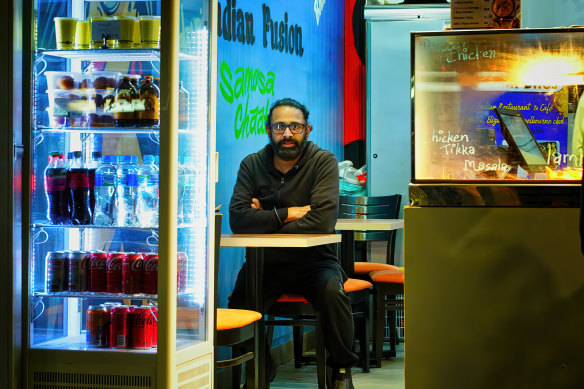
Restaurant worker Inderjit Longia says violence along Elizabeth Street has worsened.Credit: Luis Ascui
“I’m scared. I am a human being, I’ve got a family to look after, too many bills, the mortgage has gone up. We have all that stress and additional stress with all those junkies around here.”
The issues he sees have broader importance. This stretch of Elizabeth Street next to Flinders Street Station is a gateway to the CBD’s retail and entertainment core.
It is the second-busiest entry point to the city’s heart, according to pedestrian data collected by the City of Melbourne. At its busiest times, about 3000 people squeeze through the footpaths of Elizabeth Street, the data shows.
Despite its importance as an urban artery, the Elizabeth Street block between Flinders Street and Flinders Lane has a reputation as one of the CBD’s seediest spots. Logia is one of several business operators, workers, and commuters who have told The Age over numerous visits that the strip can feel out of control.
The Age is focusing on Elizabeth Street as part of a series investigating crime and antisocial behaviour troubling key thoroughfares in the CBD and the inner-city.
Elizabeth Street workers have described being punched, spat on, and abused. Two said they had to put assailants into a headlock. Staff said drug dealing and injecting in the streets was commonplace. Phone calls to the police for help often led nowhere, as troublemakers were gone by the time officers arrived.
Walking the block or waiting for a tram after dark also induces dread among those who say they have no choice but to travel that way.
Troubled city pocket
When The Age visited the street mid-morning on an unremarkable Thursday, it seemed a gathering point for some of the city’s forsaken.
A group of men knocked back cans of beer outside a tobacconist to the beat of music spilling from the store. Next to the group, a teenager who appeared to be intoxicated danced on the footpath, unbothered by passersby. “I am God,” a man who identified as Kevin said.

Elizabeth Street shopkeepers have banded together to protect each ther.Credit: Luis Ascui
Soon after, two of the men broke into an aggressive rap battle riddled with expletives that threatened to turn into a fight. “F--- that bullshit, Melbourne city,” one man barked at the other, after running his finger across his throat.
Inside a Subway restaurant, staff appeared unbothered by a man sleeping at one of the tables next to an empty wine cask and a can of cider. “He has been sleeping like this for three hours,” a worker said.
Data from the Crime Statistics Agency obtained by The Age shows crimes against the person – which includes assaults, harassment, threats, robbery, and sexual offending – along Elizabeth Street have risen by almost 57 per cent in the past five years, from 218 incidents in 2018-2019 to 342 in 2022-2023.
Property damage and theft are also on the rise, though drug dealing and possession has dropped following a spike during the pandemic.
The number of homeless, mentally ill and drug-affected people community health provider cohealth is supporting in the CBD has also tripled in the 12 months to June 2023.
“These complex social problems have been growing for some time and cannot be solved with increased policing,” chief executive Nicole Bartholomeusz said.
“Demonising people who are experiencing homelessness and mental health issues only pushes them further away from the help they need.”
The Age visited the troubled pocket at the southern end of the street several times over the past month and spoke to a dozen shopkeepers and security guards, who say they work in daily fear of thieves, vandals, and even groups of rampaging youths.
Used needles, rubbish, and drained bottles of alcohol littered the floor of an empty building in a laneway known for drug-injecting.
Salvation Army leader Brendan Nottle said Elizabeth Street had traditionally been a gathering spot for several groups because of its proximity to transport and 24-hour food outlets, but the number of people congregating at its southern end had swollen in recent years after the Metro Tunnel works forced them out of the corner of Swanston and Flinders streets and led to the closure of fast food outlets at that end of the CBD.
“Historically, it’s also been a location for dealing, so people go to that location,” Nottle said. “I think it happens because of convenience. It’s always happened there. And secondly, because it’s a transport hub.”
Nottle said many of the people regularly congregating along Elizabeth Street had housing outside of the CBD but continued to come down to the street to socialise with others after struggling to lay down roots in their new communities.
“I think our sector needs to be resourced not just to give people accommodation, but to actually address the drivers of their homelessness as well, because if we are not addressing those drivers, they’ll just gravitate back to where their communities and their friends are,” he said.
The Age has learnt a group of teenage girls threatened staff with a knife at the Subway outlet after shattering the glass door of the restaurant and stomping on a food cabinet last month.
Vandals had targeted the restaurant just two months before, smashing the screens above the counter with soft drink bottles they had snatched from the drinks fridge. Theft of knives, drinks, and food are also frequent.
Last month, thieves broke into a tobacconist shop along the street and stole vapes. The owners have since installed metal bars in the doors and windows, fearing another attack.
Drug deals, assaults
CCTV footage from two separate incidents seen by The Age shows a drug deal unfolding on the footpath outside Coles, and on another occasion, teenagers punching and chasing a man into a kebab shop. Witnesses said teens struck the man in the face with a bottle before one of them pulled out a machete.
Elizabeth Street shopkeepers said they regularly called the police, but officers often arrived after the assailants had run away from the scene. In some instances, they were arrested and later released without charge.
Once, Longia performed a citizen’s arrest after a man attempted to punch him and trashed his takeaway shop. The man was later released.
“Police came back to me and said: ‘He’s homeless. Tell me, what are we supposed to do?’. I said: ‘You tell me, you are the law, how should I know?’,” he said. “I need my workers safe, I need my customers safe, and my safety.”
The city’s spine and a dangerous swamp
Elizabeth Street was conceived as inner-Melbourne’s spine on Robert Hoddle’s grid in 1837.
It was where journeys began and ended on what became the road to Sydney, the west and the sea.
In the 1850s, it led to the tracks to the goldfields of both Ballarat and Bendigo, and its cross streets joined the city’s docks.
In 1854, Flinders Street Railway Station opened at the southern end of Elizabeth St, making the strip even more crowded and critical to travellers, commuters and carters.
The street is also a natural watercourse, an irregular floodway in a depression of Melbourne’s CBD, its flanks rising to Queen Street in the west, through Swanston Street, and up to Spring Street in the east.
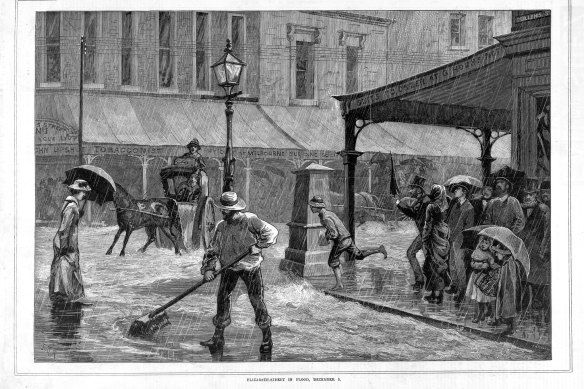
A wood engraving showing flooded Elizabeth Street in December 1882.Credit: State Libary of Victoria
Bullock teams churned the surface to deep mud in the early days. What we know as the corner of Collins Street and Elizabeth Street often enough became a dangerous swamp, its floodwaters swirling with thousands of corks, testament to the new city’s thirst.
William Westgarth, who was the first member of Melbourne City Council and the founder and first president of the Melbourne Chamber of Commerce, in the 19th century called the area a “troublesome and unhealthy hollow”, and thought it best to return it to nature.
The strip’s current dire status suggests some things have not changed much since the early Australian journalist, author and poet Marcus Clarke wrote in 1869 of the rise of takeaway food among those he wryly called Bohemians, who frequented the lower end of Elizabeth Street.
“The true and absolute Bohemian detests fixtures of all kinds, and prefers to take his meals standing, or walking, or lying, or in any posture but sitting,” wrote Clarke.
“For this purpose, the various street stalls sprung into existence. It was found that not only did honest toil going to its work at dawn require a cup of coffee to cheer its honest heart, but that vagabondism and theft, sneaking to their unholy errands, were prepared to pay for a gentle stimulant also. Upon this arose coffee stalls, pie stalls and trotterbaskets…”
Eventually, Elizabeth Street’s troublesome creek was buried in a deep drain, though floods still burst out during torrential rain. The roadway was paved and had a tramline built through its centre. Planners have since tried to balance heavy vehicular traffic alongside relentless pedestrian movement. All the while, retail and commerce carried on as if it were any other city street, rather than a hollow with a creek running beneath it.
Failed facelift attempts
At the southern end, commerce shrank to become today’s clump of cheap takeaway food businesses and convenience stores, bottle shops, two sex shops and a strip club, while successive councils dreamt about how to beautify it.
“Swanston Street went over the bridge, and therefore it always drew a lot of traffic and was a desirable location for businesses to locate, whereas Elizabeth Street is a dead end,” says Quentin Stevens, an RMIT associate professor who specialises in urban design and planning.
“Dead-end spaces always tend to attract less desirable activities because most of the traffic is avoiding them.”
Among recent efforts by the Melbourne City Council to improve the area was a streetscape facelift between Flinders Street and Flinders Lane two years ago.
The southbound roadway was closed to create new, safer public space for pedestrians, and an expanded footpath and new bluestone paving were installed, along with better street furniture.
In a further attempt to make the area more attractive, artificial grass was laid on the closed vehicle lane.
The patch of green, it turned out, proved appealing to some people the council wasn’t trying to attract.
The grass was torn up late last year when increasing numbers of homeless people began camping there, and amid what security guards and shopkeepers said was a rise in drug activity and other anti-social behaviour from outsiders drawn to the edgy and freewheeling nature of this corner of the CBD.
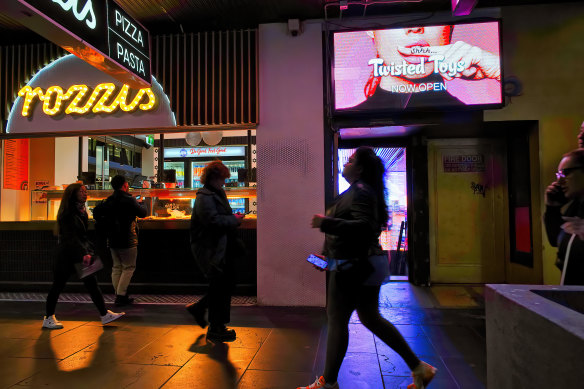
A view of Elizabeth Street at night.Credit: Luis Ascui
Ali Bukhari patrols one of the buildings on the Elizabeth Street block. The imposing security guard takes The Age to one of the laneways behind the retail strip where he says people often go to inject drugs.
Bukhari says workers are too afraid to take their rubbish to the bins in the laneway after dark.“I’ve been picking up needles, been picking up knives, on a daily basis,” he says.
Last month, emergency services had to be called to a bottle shop along the street after a teenage boy overdosed on the footpath.
“On the main street, you see a lot of regular people and a lot of new faces. And sadly, the new faces are mainly teenagers and underage young kids,” Bukhari says.
The distress of Elizabeth St traders and workers who spoke to The Age amplifies the findings of a wider survey of Melburnians undertaken for Victoria Police, which was released for public discussion earlier this month.
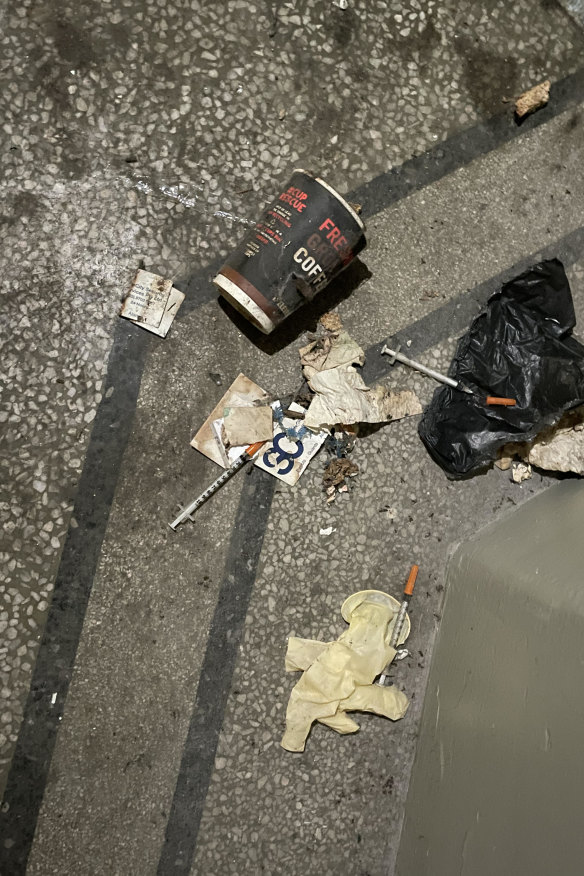
Rubbish and used needles litter the ground of an empty building in a laneway behind Elizabeth Street.Credit: Marta Pascual Juanola
The Victoria Police Community Sentiment Survey 2023 found Melbourne’s top two safety concerns in 2023 were safety in public places and drug and alcohol. Among the issues raised by the 558 respondents were street violence, verbal abuse and harassment, and public drunkenness and drug taking.
Victoria Police say there is a dedicated, 24/7 robust police presence in the city, supported by regular proactive operations to prevent crime, target offenders and improve overall safety.
They point to Operation Protocol, an ongoing initiative police run with The Salvation Army and the City of Melbourne to engage with those experiencing homelessness and connect them to essential services.
The operation also targets anti-social behaviour around Elizabeth, Swanston, and Bourke streets, a police spokesperson said.
The City of Melbourne’s budget for 2023–24 includes almost $6 million for safety infrastructure and resources, including lighting in key precincts and CCTV cameras. There’s also $100,000 to expand the Salvation Army’s street team.
Locals protect each other
Shopkeepers, security guards and workers on the strip, however, say they usually have to deal with problems themselves. Security guards regularly band together to help out other businesses when trouble arises.
Nav Mann, a worker at a burger restaurant across the road from Flinders Street Station, said troublesome customers sometimes followed staff home and tried to harass them further.
“It was pretty safe back in the day. People used to come out a lot. These days it’s been worse and worse,” she says.
“The kids are threatening people, so people are feeling unsafe to come outside, and for us, it’s very unsafe to work here as well during the night.”
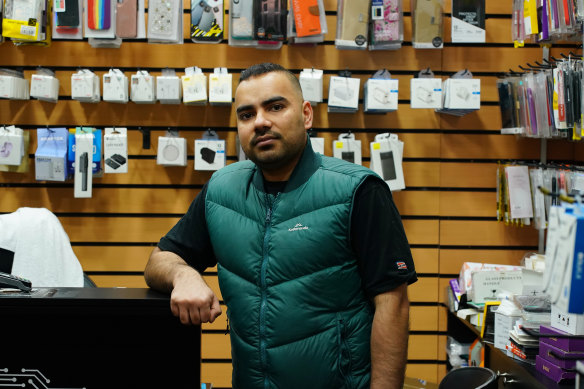
Phone repair store owner Sandeep Josan.Credit: Luis Ascui
Most traders said the serious antisocial behaviour plaguing the block came from people drawn to the area from elsewhere to drink in the street and inject drugs in the alleyways behind the businesses, rather than a core cohort of street dwellers they call “the regulars”.
“There are a lot of new faces that have been coming here, so it’s like a gathering spot for them. They are only here for one or two days, and they disappear somewhere else, but they are the ones that cause the trouble most of the time,” said a staff member from one of the two sex shops on the strip, who did not want to be identified by name. “The regulars know the rules.”
Outside Longia’s takeaway shop, one of the regulars known as Uncle, swooshes away troublemakers with a swift flick of an arm. Uncle, who struggles to communicate as he is hard of hearing, spends most of his time along the busy strip and has built relationships with most workers.
Longia jokes that the stocky middle-aged man is a de facto security guard for the street, keeping in check drug-affected people who bother traders.
When The Age visited the strip earlier this month, Uncle was sitting outside Longia’s takeaway shop with another regular, a hip-hop artist known as Venom, who has made wearing a blue sequin cowboy hat his signature look.
Venom says people like to come down to that pocket of Elizabeth Street because it’s “chill” and there are services, 24-hour restaurants, and public transport at nearby.
Urban planner Quentin Stevens said Elizabeth Street’s position as a major transport hub could explain the issues with crime.
“For there to be crime, or for there to be perceptions of crime, there have to be victims of crime, and transport hubs are places where all kinds of people mix together, the good and the bad,” he said.
“If there is an answer to crime in public, it is making sure there are activities and people facing onto the spaces where innocent people are coming and going.”
This could include parklets and al fresco dining areas, which traders like mobile repair shop owner Sandeep Josan have been crying out for since the artificial turf was ripped up last year.
“If they make it nice there again with the grass, and they put some sort of tables, maybe the street will look more appealing to customers and maybe if it’s occupied, they won’t camp there and play loud music,” Josan says.
Maybe.
With Tony Wright
The Morning Edition newsletter is our guide to the day’s most important and interesting stories, analysis and insights. Sign up here.